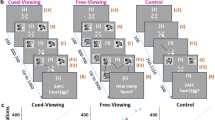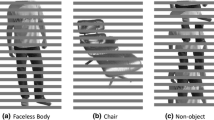Abstract
Human visual evoked potentials were recorded during presentation of photos of human and animal faces and various face features. Negative waves with approximate peak latencies of 165 msec (N170) were bilaterally recorded from the occipito-temporal regions. Mean peak latencies of the N170 were shorter for faces than eyes only. Analyses of amplitudes of evoked potentials indicated that the N170 elicited by faces reflected activity of a specific neural system which was insensitive to detailed differences among individual faces regardless of species, and consequently suggest that this system might function to detect existence of faces in general. On the other hand, the mean amplitude of the N170 elicited by human eyes was significantly larger than those by animal eyes. These differences in response latencies and amplitudes of the N170 suggest existence of at least 2 different visual evoked potentials with similar latencies (i.e., N170) which are sensitive to faces in general and human eyes, respectively. Dipole source localization analysis indicated that dipoles for the N170 elicited by eyes were located in the posterior inferior temporal gyrus, and those for faces, located initially in the same region, but moved toward the fusiform and lingual gyri at the late phase of the N170. The results indicated that information processing of faces and eyes separated at least as early as the latency of the N170 at the posterior inferior temporal gyrus as well as the fusiform and lingual gyri, and might provide neurophysiological and anatomical bases to an initial structural encoding stage of human faces.
Similar content being viewed by others
References
Allison, T., Ginter, H., McCarthy, G., Nobre, A.C., Puce, A., Luby, M. and Spencer, D.D. Face recognition in human extrastriate cortex. J. Neurophysiol., 1994a, 71: 821–825.
Allison, T., McCarthy, G., Nobre, A.C., Puce, A. and Belger, A. Human extrastriate visual cortex and the perception of faces, words, numbers,andcolors. Cereb. Cortex, 1994b, 5: 544–554.
Allison, T., Puce, A., Spencer, D.D. and McCarthy, G. Electrophysiological Studies of Human Face Perception. I: Potentials generated in occipitotemporal cortex by face and non-face stimuli. Cereb. Cortex, 1999, 9: 415–430.
Bentin, S., Allison, T., Puce, A., Perez, E. and McCarthy, G. Electrophysiological studies of face. Perception in humans. J. Cognit. Neurosci., 1996, 8: 551–565.
Bötzel, K., Schulze, S. and Stodieck, S.R. Scalp topography and analysis of intracranial sources of face-evoked potentials. Exp. Brain Res., 1995, 104: 135–143.
Bruce, V. and Young, A. Understanding face recognition. Br. J. Psychol., 1986, 77: 305–327.
Clark, V.P., Keil, K., Maisog, J.M., Courtney, S.M., Ungerleider, L.G. and Haxby, J.V. Functional magnetic resonance imaging of human visual cortex during face matching: a comparison with positron emission tomography. Neuroimage, 1996, 4: 1–15.
Clarke, S., Lindemann, A., Maeder, P., Borruat, F.-X. and Assal, G. Face recognition and postero-inferior hemispheric lesions. Neuropsychologia, 1997, 35: 1555–1563.
DeRenzi, E. Prosopagnosia in two patients with CTscan evidence of damage to the right hemisphere. Neuropsychology, 1986, 24: 385–389.
Eifuku, S., De Souza, W.C., Nishijo, H., Tamura, R. and Ono, T. Neuronal activity of monkey anterior temporal cortex including perirhinal cortex and area STPa during face identification. Soc. Neurosci. Abstr., 1999, 25:916.
Eimer, M. Does the face-specific N170 component reflect the activity of a specialized eye processor? Neuroreport, 1998, 9: 2945–2948.
Eimer, M. and McCarthy, R.A. Prosopagnosia and structural encoding of faces: Evidence from event-related potentials. Neuroreport, 1999, 10: 253–259.
Eimer, M. Event-related brain potentials distinguish processing stages involved in face perveption and recognition. Clin. Neurophysiol., 2000, 111: 694–705.
Fraser, I. and Paker, D. Reaction time measures of feature saliency in a perceptual integration task. Aspects of face processing, 1986: 45–52.
George, N., Evans, J., Fiori, N., Davidoff, J. and Renault, B. Brain events related to normal and moderately scrambled faces. Cogn. Brain. Res., 1996, 4: 65–76.
Halgren, E., Raij, T., Marinkovic, K., Jousmäki, V. and Hari, R. Cognitive response profile of the human fusiform face area as determined by MEG. Cereb. Cortex, 2000, 10: 69–81.
Hasselmo, M.E., Rolls, E.T., Baylis, G.C. and Nalwa, V. Object-centered encoding by face-selective neurons in the cortex in the superior temporal sulcus of the monkey. Exp. Brain Res., 1989, 75: 417–429.
Hayashi, N., Nishijo, H., Ono, T., Endo, S. and Tabuchi, E. Generators of somatosensory evoked potentials investigated by dipole tracing in the monkey. Neuroscience, 1995, 68: 323–338.
Haxby, J.V., Horwitz, B., Ungerleider, L.G., Maisog, J.M., Pietrini, P. and Grady, C.L. The functional organization of human extrastriate cortex: a PET-rCBF study of selective attention to faces and locations. J. Neurosci., 1994, 14: 6336–6353.
Haxby, J.V., Ungerleider, L.G., Horwitz, B., Rapoport, S.I. and Grady, C.L. Hemispheric differences in neural systems for face working memory: a PET-rCBF study. Hum. Brain Mapp., 1995, 3: 68–82.
He, B., Musha, T., Okamoto, Y. and Homma, S. Electric dipole tracing in the human brain by means of the boundary element method and its accuracy. IEEE. Trans. Biomed. Eng., 1987, 34: 406–414.
Homma, S., Musha, T., Nakajima, Y., Okamoto, Y., Blom, S., Flink, R., Hagbarth, K.E. and Mostrom, U. Localization of electric current sources in the human brain estimated by the dipole tracing method of the scalp-skull-brain (SSB) head model. Electroencephalor. Clin. Neurophysiol., 1994, 91: 374–382.
Ishai, A., Ungerleider, L.G., Martin, A. and Haxby, J.V. The representation of objects in the human occipital and temporal cortex. J. Cog. Neurosci., 2000, 12 (Suppl. 2): 35–51.
Ikeda, H., Nishijo, H., Miyamoto, K., Tamura, R., Endo, S. and Ono, T. Generators of visual evoked potentials investigated by dipole tracing in the human occipital cortex. Neuroscience, 1998, 84: 723–739.
Jemel, B., George, N., Chaby, L., Fiori, N. and Renault, B. Differential processing of part-to-whole and part-to-part face priming: anERPstudy. Neuroreport, 1999, 10: 1069–1075.
Kanwisher, N., McDermott, J. and Chun, M.M. The fusiform face area: a module in human extrastriate cortex specialized for face perception. J. Neurosci., 1997, 17: 4302–4311.
Kanwisher, N., Stanley, D. and Harris, A. The fusiform face area is selective for faces not animals. Neuroreport, 1999, 10: 183–187.
McCarthy, R.A. and Warrington, E.K. Visual associative agnosia: a clinico-anatomical study of a single case. J. Neurol. Neurosurg. Psychiat., 1986, 49: 1233–1240.
McCarthy, G., Puce, A., Belger, A. and Allison, T. Electrophysiological studies of human face perception.II: Response of properties of face-specific potentials generated in occipitotemporal cortex. Cereb. Cortex, 1999, 9: 431–444.
Musha, T. and Homma, S. Do optimal dipoles obtained by the dipole tracing method always suggest true source locations? Brain Topogr., 1990, 3: 143–150.
Nishijo, H., Hayashi, N., Fukuda, M. and Ono, T. Localization of dipole by boundary element method in three-dimensional reconstructed monkey brain. Brain Res. Bull., 1994, 33: 225–230.
Nishijo, H., Ikeda, H., Miyamoto, K., Endo, S. and Ono, T. Localization of an ictal onset zone using a realistic 4-shell head model of scalp, skull, liquor, and brain. Soc. Neurosci. Abstr., 1996, 22: 185.
Perrett, D.I, Heitanen, J.K, Oram, M.W. and Benson, P.J. Organization and functions of cells responsive to faces in the temporal cortex. Philos. Trans. R. Soc. Lond. B., 1992, 335: 23–30.
Perrett, D.I. and Oram, M.W. Visual recognition based on temporal cortex cells: viewer-centered processing of pattern configuration. Z. Naturforsch. [C], 1998, 53: 518–541.
Perrett, D.I., Rolls, E.T. and Caan, W. Visual neurons responsive to faces in the monkey temporal cortex. Exp. Brain Res., 1982, 47: 329–342.
Rolls, E.T. Neurophysiological mechanisms underlying face processing within and beyond the temporal cortical visual areas. Philos. Trans. R. Soc. Lond. B., 1992, 335: 11–20.
Rolls, E.T. Functions of the primate temporal lobe cortical visual areas in invariant visual object and face recognition. Neuron, 2000, 27: 1–20.
Puce, A., Allison, T., Gore, J.C. and McCarthy, G. Face-sensitive regions in human extrastriate cortex studied by functional MRI. J. Neurophysiol., 1995, 74: 1192–1199.
Puce, A., Allison, T., Bentin, S., Gore, J.C. and McCarthy, G. Temporal cortex activation in humans viewing eye and mouth movements. J. Neurosci., 1998, 18: 2188–2199.
Sams, M., Hietanen, R., Hari, R., Ilmoniemi, J. and Lounasmaa, V.O. Face-specific responses from the human inferior occipito-temporal cortex. Neuroscience, 1997, 77: 49–55.
Sergent, J., Ohta, S. and MacDonald, B. Functional neuroanatomy of face and object processing a positron emission tomography study. Brain, 1992, 115: 15–36.
Sergent, J. and Poncet, M. From covert to overt recognition of faces in a prosopagnosic patient. Brain, 1990, 113: 989–1004.
Sugase, Y., Yamane, S., Ueno, S. and Kawano, K. Global and fine information coded by single neurons in the temporal visual cortex. Nature, 1999, 400: 869–873.
Suzuki, S. and Cavanagh, P. Facial organization blocks access to low-level features: An object inferiority effect. J. Exp. Psychol., 1995, 21: 901–913.
Swithenby, S.J., Bailey, A.J., Brtigam, S., Josephs, O.E., Jousmäki, C.D. and Tesche, C.D. Neural processing of human faces: a magnetoencephalographic study. Exp. Brain Res., 1998, 118: 501–510.
Takahashi, N., Kawamura, M., Hirayama, K., Shiota., J. and Isono, O. Prosopagnosia: a clinical and anatomical study of four patients. Cortex, 1995, 31: 317–29.
Tanaka, J.W. and Farah, M.J. Parts and wholes in face recognition. Q. J. Exp. Psychol. A, 1993, 46: 225–245.
Watanabe, S., Kakigi, R., Koyama, S. and Kirino, E. Human face perception traced by magneto-and electroencephalography. Cog. Brain Res., 1999a, 8: 125–142.
Watanabe, S., Kakigi, R., Koyama, S. and Kirino, E. It takes longer to recognize the eyes than the whole face in humans. Neuroreport, 1999b, 10: 2193–2198.
Author information
Authors and Affiliations
Rights and permissions
About this article
Cite this article
Shibata, T., Nishijo, H., Tamura, R. et al. Generators of Visual Evoked Potentials for Faces and Eyes in the Human Brain as Determined by Dipole Localization. Brain Topogr 15, 51–63 (2002). https://doi.org/10.1023/A:1019944607316
Issue Date:
DOI: https://doi.org/10.1023/A:1019944607316




